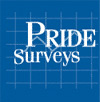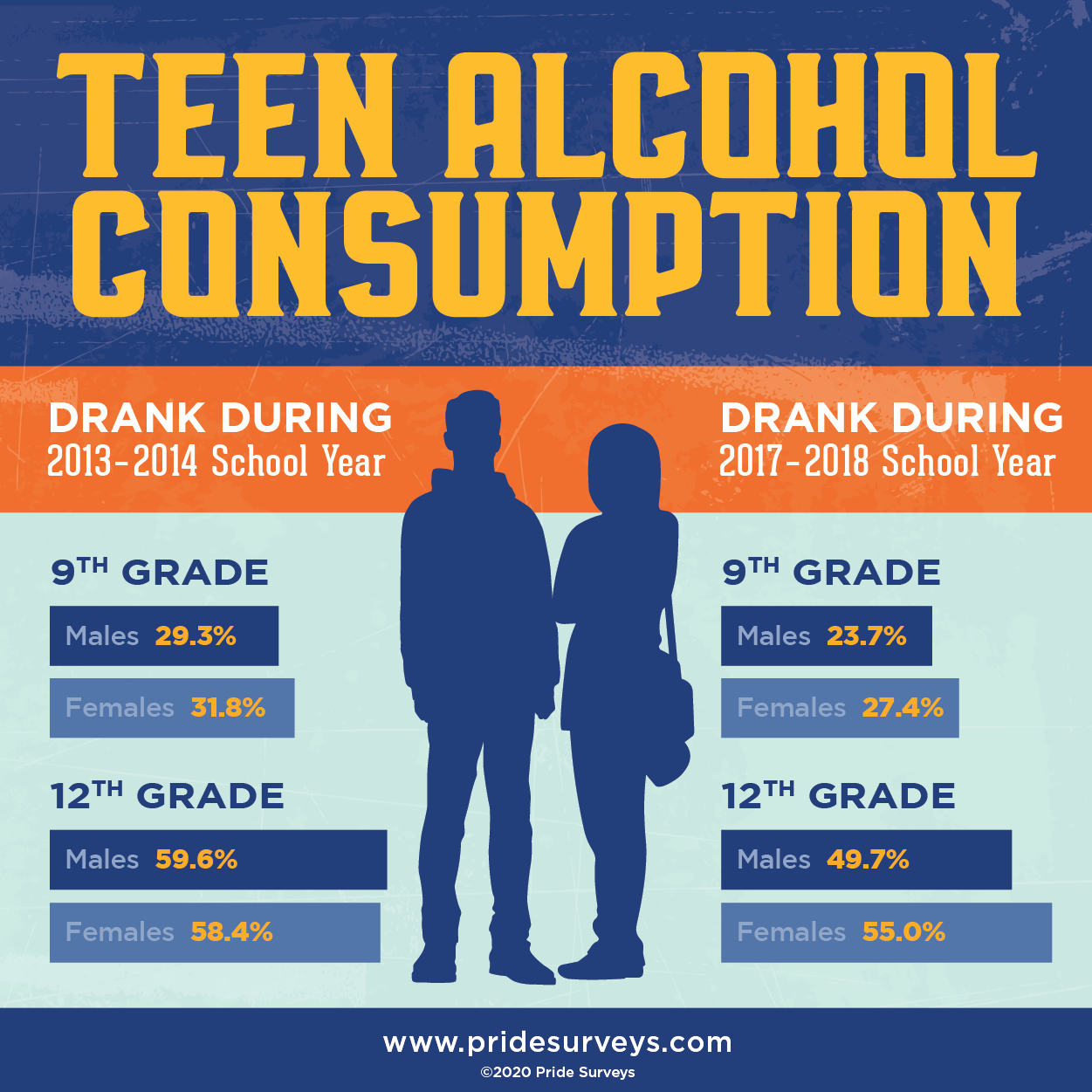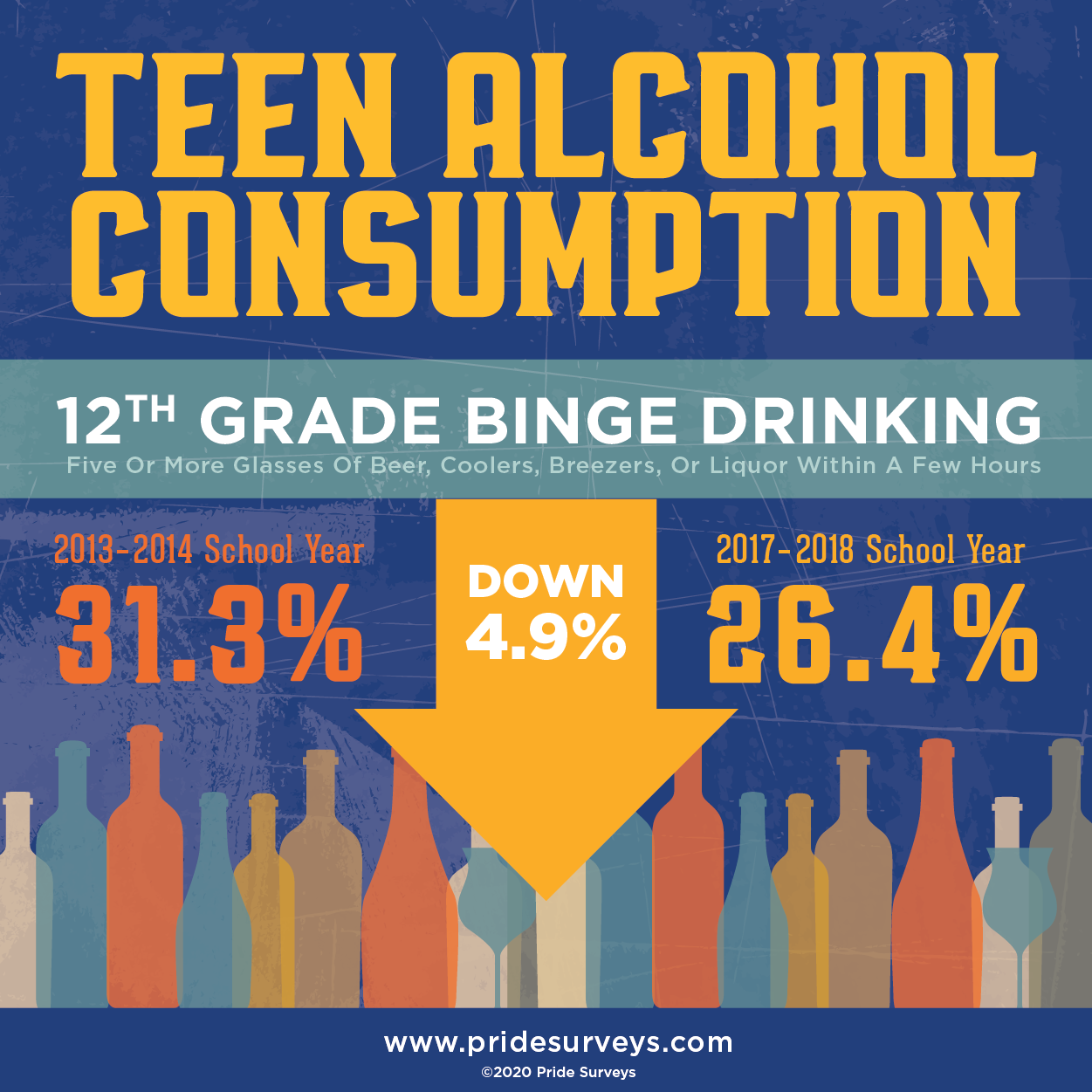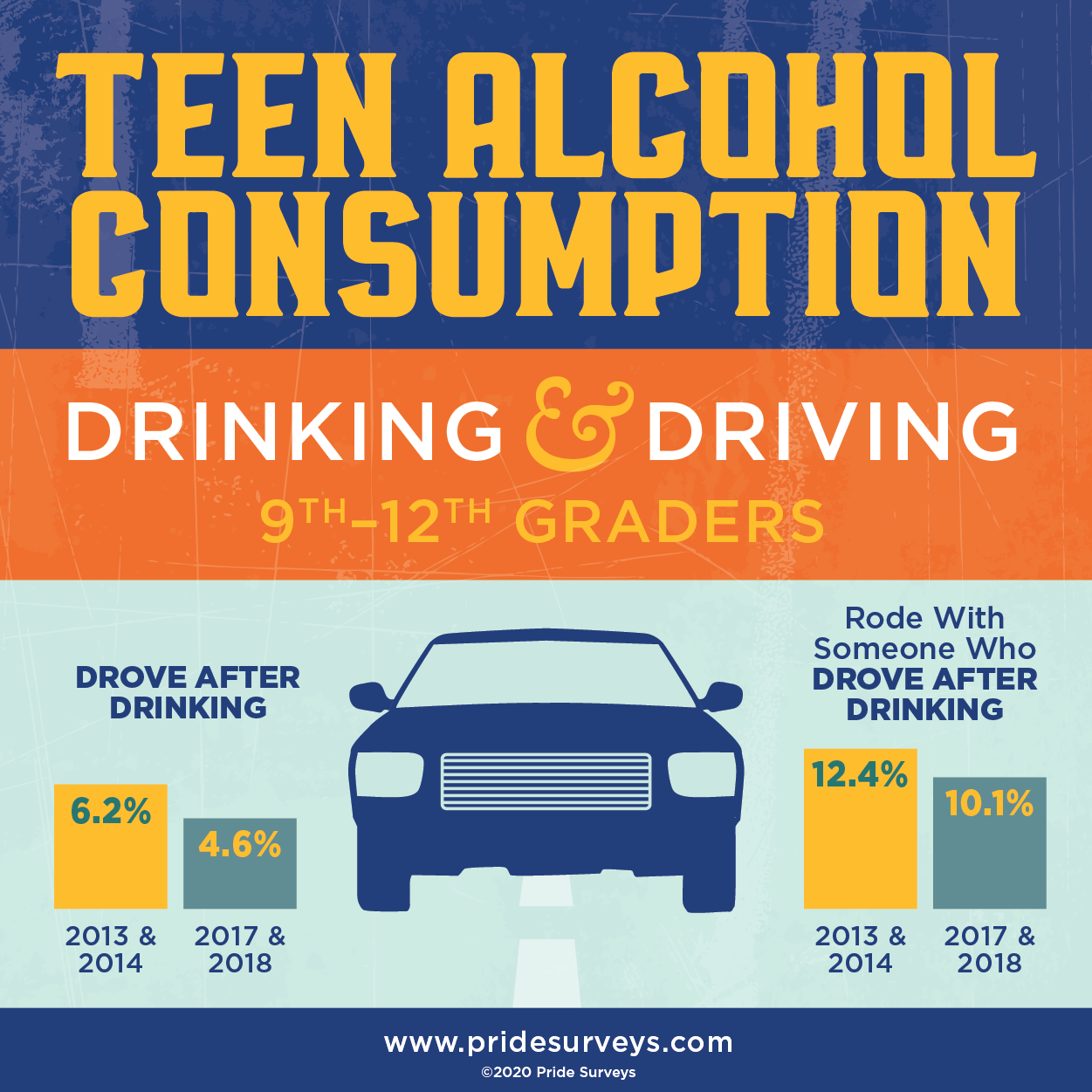Sign up for our information-filled email newsletter

Student Alcohol Use: April is Alcohol Awareness Month
Every April, the National Council for Alcoholism and Drug Dependence (NCADD) sponsors Alcohol Awareness Month to increase understanding and awareness of alcoholism, a rising epidemic in the United States. Here at Pride Surveys, we are actively committed to working with our partners in education and community coalitions to provide data, research, and resources surrounding student alcohol use and the substance abuse epidemic amongst youth. When national awareness months like this come around, we can give concise information on rising trends, symptoms, and behaviors.
For many in the United States, alcohol use is ingrained in the culture and entertainment as well as the social lives of some youth. According to the National Institute on Alcohol Abuse and Alcoholism, student alcohol use remains a pervasive problem. The percentage of teenagers who drink alcohol is reported to be slowly declining; however, numbers are still high. About 25.6 percent of adolescents report consuming alcohol by 8th grade, and about 41.7 percent report being drunk at least once by 12th grade.
But, what causes casual use for youth to become an addiction?
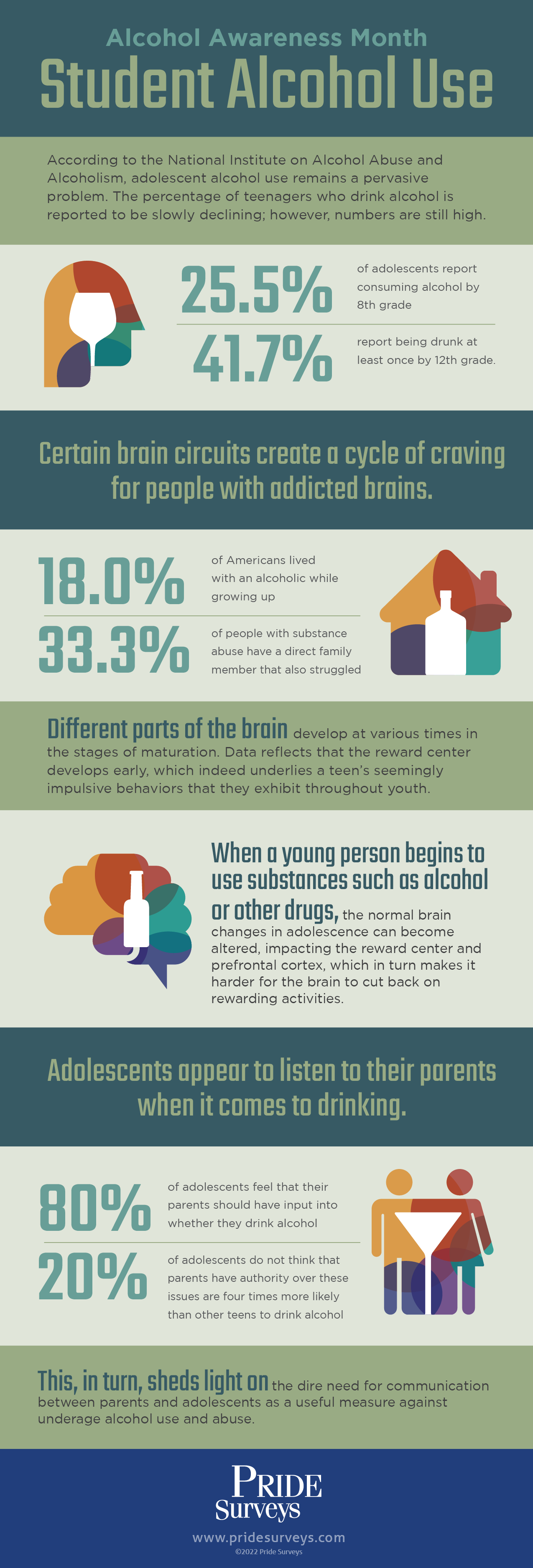
Pride Surveys | Student Alcohol Use – Alcohol Awareness Month
Research shows that certain brain circuits create a cycle of craving for people with addicted brains. People with trauma in their childhoods or a family history of addiction are at greater risk by a substantial amount. It is reported that almost one in five Americans, close to 18%, lived with an alcoholic while growing up and that one-third of people who struggle with substance abuse have a direct family member that also struggled. Seemingly just as important is the age at which someone is when they start to use alcohol. Research points to the fact that when someone starts earlier, the likelihood of becoming addicted later is higher due to the development patterns of the adolescent brain.
Most statistics suggest that developing brains are not at what are considered “adult levels” until their mid-twenties, with different parts of the brain developing at various times in the stages of maturation. Data reflects that the reward center develops early, which indeed underlies a teen’s seemingly impulsive behaviors that they exhibit throughout youth. Just think about what you did in your youth versus what you would do now. The prefrontal cortex then serves as the brakes on reward-driven impulse behaviors. But this part of the brain isn’t mature until the mid-twenties.
When a young person begins to use substances such as alcohol or other drugs, the normal brain changes in adolescence can become altered, impacting the reward center and prefrontal cortex, which in turn makes it harder for the brain to cut back on rewarding activities.
The good news is that adolescents appear to listen to their parents when it comes to drinking, especially if the messages are consistently given and with authority. Research suggests that the majority of adolescents, around 80 percent, feel that their parents should have input into whether they drink alcohol. Interestingly, those in the minority who do not think that parents have authority over these issues are four times more likely than other teens to drink alcohol and three times more likely to have plans to drink if they have not already started.
Research also points to that, regardless of unique parenting styles, youth who understand that their parents will be upset or more likely to punish them if they drank tend to be less likely to do so, at least in their underage years. This, in turn, sheds light on the dire need for communication between parents and adolescents as a useful measure against student alcohol use and abuse.
There are many resources and initiatives that have been developed throughout the years by other notable organizations that support communities and children by educating students and parents about the dangers and consequences of student alcohol use and abuse. One of the many reasons these organizations exist is due to support from companies such as Pride Surveys, which focuses on student data collection, trends, and shifts over time in the data covering substance abuse. Data collection is crucial in informing parents, students, educators, and community coalitions about substance use disorders and drug prevention.
If you notice signs of student alcohol use or alcohol abuse in someone you love, it is imperative to reach out to professionals. If your community coalition or school needs data to determine substance use and abuse issues that may be occurring, please get in touch with the Pride Surveys team. We offer a variety of substance abuse survey options to fit many needs.
Resources
Jackson, C. Perceived legitimacy of parental authority and tobacco and alcohol use during early adolescence. Journal of Adolescent Health 31(5):425–432, 2002.
Squeglia, L.M.; Jacobus, J.; and Tapert, S.F. The influence of substance use on adolescent brain development. Clinical EEG and Neuroscience 40(1):31–38, 2009.
Adolescent Substance Abuse: America’s #1 Health Problem, The National Center on Addiction and Substance Abuse at Columbia University, June 2011
America’s Dropout Crisis: The Unrecognized Connection to Adolescent Substance Abuse, DuPont et al., Institute for Behavior and Health, Inc., March 2013
https://www.thewoodsatparkside.com/why-is-alcohol-addictive-for-some-people-and-not-others/
https://americanaddictioncenters.org/alcoholism-treatment/symptoms-and-signs/hereditary-or-genetic
Alcohol Awareness Month and Student Alcohol Trends
Alcohol Awareness Month is an annual initiative designed to raise awareness about alcohol trends, use, and addiction and provide resources for those in need and those community coalitions, parents, and educators trying to help others. At Pride Surveys, alcohol use and abuse are some of our more frequently surveyed questions for students and across community coalitions.
While the below data looks at 2015 to 2019, Pride Surveys will be paying especially close attention to the 2020 data once available to see alcohol trends and changes due to the start of the COVID-19 pandemic and quarantines. Preliminary data suggests that students are spending more time at home and have less access to alcohol than they normally would due to the pandemic.
For additional information, the CDC provides significant resources and data for alcohol use and prevention, mental health and stress impacts on alcohol use, and more, including pandemic considerations.

Pride Surveys Teen Alcohol Statistics
Alcohol Consumption Amongst Students
Recent Pride Surveys data reveals several alcohol trends amongst students from 6th to 12th grade between the years of 2015 to 2019.
One positive trend for those who said “yes” to consuming alcohol over the past year is that, with the exception of a 1.2% increase for eighth grade students, all other grades from six to twelve show a decrease in consumption over the course of five years. That said, there was a significant increase in 12th grade alcohol use from 2018 to 2019, with a 3.3% increase in those reporting “yes” to use in the past year.
Past 30-day use (i.e., when students report that they have used a substance at least once in the past 30 days), is viewed as the best measure of ongoing use of that substance.
For alcohol use, most “yes” responses decreased over the five-year period however, there was again an increase in 12th-grade consumption between 2018 and 2019, with 4% more reporting “yes.”
Access to Alcohol
Another question on the substance abuse student surveys relates to how easy it is for students to get alcohol. Pride Surveys is happy to report an overall year-over-year decrease of underage youth being able to obtain alcohol. There are specific laws for “Social Hosting,” or knowingly providing minors with access to alcohol, which vary by state, and something that coalitions can work with their partners to implement to hold parents accountable for serving underage youth.
Drinking and Driving/Riding
Pride Surveys data has also shown a decrease in drinking and driving year over year in addition to a decrease in riding in a car or other vehicle with someone who has been drinking. Of concern, however, data shows that 10.4% of females and 7.4% of males surveyed in 2019 rode in a car at least once with someone who had been drinking.
For plentiful resources and safety measures for community coalitions, parents, and educators as it relates to student alcohol trends, awareness, and use, please visit our 2020 Alcohol Awareness Month blog post.
Pride Surveys features a significant number of online and paper Substance Abuse Surveys, including surveys on alcohol awareness and use, in addition to other topics that are critical to community coalitions and schools. Please call us today at 800-279-6361 or fill out our quick online contact form.
Sources:
https://www.cdc.gov/coronavirus/2019-ncov/daily-life-coping/stress-coping/alcohol-use.html
Red Ribbon Week | Youth Drug Use Statistics and Prevention
Red Ribbon Week is an annual initiative between October 23rd and October 31st dedicated to helping kids stay drug-free. At Pride Surveys, we hope to provide as many statistics and resources around this critical topic as possible in order to support parents, schools, and community coalitions, all of whom are equally passionate about keeping children from using drugs of all varieties.
In light of Red Ribbon Week, we analyzed the drug use trends over the past five years (2014-2018), with a focus on the data surrounding smoking cigarettes, drinking alcoholic beverages, marijuana use, and prescription drug use, in particular.
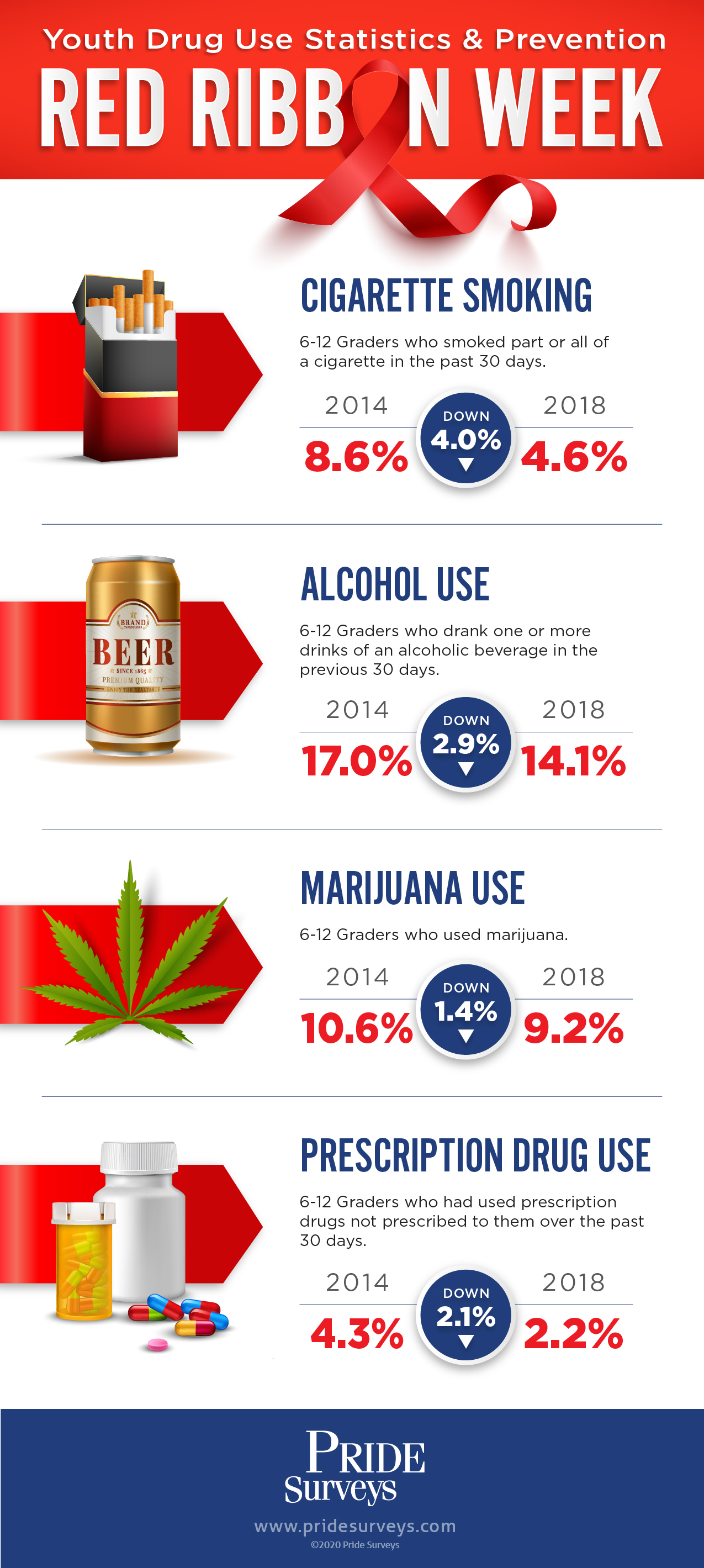
Pride Surveys Red Ribbon Week Youth Drug Use Statistics and Prevention
Cigarette Smoking Trends and Resources
Pride Surveys data reveals that there has been a very positive decrease in cigarette smoking in children grades six through twelve, with the numbers dropping from 8.6% reporting they smoked part or all of a cigarette in the past 30 days (2014) to 4.6% reporting they did (2018).
For resources related to cigarette smoking in youth, please visit our World No Tobacco Day blog post.
Alcohol Use Trends and Resources
From 2014 to 2018, Pride Surveys data shows that when asked if they drank one or more drinks of an alcoholic beverage in the previous 30 days, the numbers decreased overall by 2.9% (17% to 14.1%). There was an uptick from 2017 to 2018, with 12.9% of youth reporting they had consumed alcohol in 2017 versus 14.1% in 2018.
For additional data on binge drinking, drinking and driving, alcohol consumption by grade, and resources for identifying if teens are using alcohol and ways to help prevent them from doing so, please visit our National Alcohol Awareness Month blog post.
Marijuana Use Trends and Resources
Pride Surveys data for marijuana use shows that while the numbers have decreased between 2014 to 2018 from 10.6% to 9.2%, there was also an uptick from 2016 and 2017 (8.2% each year) to 2018 (9.2%).
The Red Ribbon Week website, Drugfree.org, and Stanford Children’s Health provide a significant number of ways to speak with kids about marijuana use and the dangers surrounding it.
Prescription Drug Use Trends and Resources
In large part, due to our community coalition partners’ phenomenal work, the great news is that prescription drug use in grades six through twelve has dropped almost in half based on the data. When asked if they had used prescription drugs not prescribed to them over the past 30 days, there was a decline with 4.3% of youth surveyed reporting “yes” in 2014 versus 2.2% in 2018.
Our blog post on the topic provides ample information on warning signs, risk factors, and the “why” behind prescription drug use in children.
At Pride Surveys, we remain committed to consistently providing our community coalition and school colleagues with up-to-date survey data and resources on issues impacting youth from Red Ribbon Week throughout the course of each year. While 2020 looks significantly different than years past, the more community coalitions stay involved with and support youth and the more activities and programs teens and middle schoolers are involved in, the less likely they are to imbibe in drugs and alcohol.
Should you have questions or be interested in an online or paper survey related to substance abuse or other topics, please reach out to our team to learn more.
Resources:
https://www.redribbon.org/resources
https://drugfree.org/article/how-to-talk-about-marijuana/
https://healthier.stanfordchildrens.org/en/talking-with-your-teen-about-marijuana/
National Alcohol Awareness Month | Alcohol Usage Trends
At Pride Surveys, we work with a number of community coalitions around the country, and one of the top concerns and top survey topics for high school students is about alcohol usage. Specifically, coalitions want to know from year to year how students get their alcohol, how much they drink, how often, and where they drink. They can use these statistics to track the implementation of their alcohol use reduction programs and the impact of their awareness campaigns. National Alcohol Awareness Month is a public health program that takes place annually in April. It is put on by the National Council on Alcoholism and Drug Dependence to expand the knowledge and outreach about the dangers of alcohol and alcoholism. While initially targeted toward college students in its inception in 1987, it has since become a national movement to increase education and attention beyond the university age group.
Examining Pride Surveys’ national data, over the course of the last five years, students are reporting less alcohol usage due to, in part, the phenomenal work community coalitions around the country are doing.
Pride Surveys data from high school surveys consistently tell meaningful stories about consumption, alcohol usage, and trends. Breaking out the data by gender, the analysis of data over five years tells the story that males and females have similar rates of alcohol usage in grades nine through eleven, with males using more once they reach 12th grade. Use trends for both genders increase significantly as youth advance in grade and age.
A positive decrease from the data shows that the trend of binge drinking, which Pride Surveys defines as five or more glasses of beer, coolers, breezers, or liquor within a few hours, has decreased significantly. In 12th graders, students reported binge drinking decreased by 4.9% since 2015. This data is further supported by other national surveys like the MTF that also shows a decrease in Binge drinking nationwide. [1]
One of the biggest concerns and dangers relates to the consumption of alcohol before driving a car or riding in a car with someone who has consumed alcohol. The positive news is that year over year over a five-year period, these numbers have shown a decrease, with 6.2% of students from 9th to 12th grade reporting that they drove a car or other vehicle when they had been drinking alcohol over the previous 30-day period in 2013-14. This number dropped 1.6% by 2017-18. For those who rode in a car or other vehicle driven by someone who had been drinking alcohol in the past 40 days, the numbers reported by high school students revealed a 2.3% decrease over a five-year period.
For schools and community coalitions, it is critical to be aware and mindful of some of the identifiable risk factors for teen alcohol consumption. Several of these include genetic predisposition and exposure, biologic markers, psychiatric disorders, and childhood behavior, such as being easily distracted, restless, and/or aggressive. [2]
In 2020, there are many great resources and safety measures community coalitions can benefit from as they continue to drive the decrease in alcohol consumption in youth. The National Institute of Alcohol Abuse and Alcoholism offers significant resources, as does SAMHSA. Mothers Against Drunk Driving (MADD) offers valuable lessons, volunteer opportunities, and ways to take action from a local to a national level.
The Center for Disease Control reports the sobering statistic that more than 4,300 deaths in underage youth are caused by excessive drinking, and there is a myriad of negative impacts from alcohol usage that can affect teens, from risky behavior to impaired development and a decrease in impulse control. The consequences don’t end with the individuals; they take a toll on the community in the form of lost lives, lost productivity, and an increase in costs related to healthcare. Together, with the use of our surveys and the commitment by community coalitions to implement programs that make a difference in their communities, we will continue to decrease these numbers.
Pride Surveys features a significant number of Substance Abuse Surveys that can be targeted to specific age groups and needs with communities and ask the hard questions about alcohol usage you need to ask in a school survey in order to make positive changes in your community. Please call us today at 800-279-6361 or fill out our quick online contact form.
For additional resources and information about making a community impact, please subscribe to our monthly Survey Sentinel newsletter.
Sources:
[1] Monitoring The Future: High School and Youth Trends. Retrieved 26 March 2020 at https://www.drugabuse.gov/publications/drugfacts/monitoring-future-survey-high-school-youth-trends.
[2] National Institute on Alcohol Abuse and Alcoholism. Retrieved 23 March 2020 at https://pubs.niaaa.nih.gov/publications/aa37.htm
Pride Surveys National Summary Data
https://www.ncbi.nlm.nih.gov/books/NBK37591/
What Alcohol Does to Teens
We’ve written before about how drugs affect teens bodies and their brains, and we continue our series here with how alcohol affects teens. A teenager’s brain is constantly being redesigned and restructured under the influence of massive hormonal changes.[1] Add to this the influence of a drug like alcohol, and it can be a dangerous combination.
Alcohol is the most frequently abused substance by adolescents in the United States. 21% of kids admit to trying alcohol before the age of 13, and 79% have tried alcohol by the end of high school.[2] This window from 9th through 12th grade is an opportunity for community leaders, educators, and administrators to change lives with effective youth alcohol and drug abuse prevention projects. Statistics from surveys by the Substance Abuse and Mental Health Services Administration (SAMHSA) tell us that every day nearly 5000 kids in the U.S. under the age of 16 take their first drink.[3]
The Pride Survey for grades 6-12 2016-17 National Data Set shows that 7.7% of students in grades 9-12 surveyed reporting they use alcohol.[4] In the same 2016-17 survey, 10% of junior high schoolers reported using alcohol in the last year.[5] In 2014, more than 1.6 million kids – almost 4.4% – between the ages of 12 and 20 reported driving under the influence of alcohol in the past year.[6] Alcohol is connected to the leading causes of death (car accidents, homicides, and suicides) for this age range.[7]
Effects of Alcohol on Teens
Alcohol is a dissociative and a depressant and may initially make someone appear more emotional or their behaviors more exaggerated. The short-term effects of alcohol on the body are the feelings of being “drunk.” On average, the liver of a typical, healthy adult can metabolize about one serving of alcohol per hour, depending on the age, weight, and gender of the person.[8] Typically, consuming more than one beverage per hour leads to intoxication.[9] For someone in their teens, drinking any alcohol can quickly get out of hand and become dangerous. Some of the effects of alcohol on teens’ bodies include:
- Loss of physical coordination including poor balance, slurred speech or blurred vision making even basic functions more hazardous.[10]
- Slower brain activity
- Skin flushing
- Dilated pupils
- Mood swings
- Raised blood pressure and heart rate
- Reduced core body temperature
- Decreased impulse control
- Loss of Inhibitions[11]
- Poor decision making.[12]
- Risky behaviors like drunk driving, fights, or unwanted sexual situations.[13]
- Sleepiness, passing out or blacking out.[14]
- Reflexes like breathing and gagging can be suppressed leading to choking or death.[15]
Alcohol and drugs also cause impaired development and potential long-term damage in teens. Alcohol can create “Swiss cheesing” to young brains so “some areas function normally, and others, like the holes in the cheese, under-function.”[16] This alteration to the structure occurs throughout the brain, but the pre-frontal cortex – the part of the brain that controls reasoning and impulses – is markedly affected.[17]
Teens and Binge Drinking
National Institute on Alcohol Abuse and Alcoholism defines binge drinking as consuming four drinks in a row raising the blood alcohol concentration (BAC) to 0.08% or greater. This BAC is the legal limit for driving under the influence in most states and typically occurs after four drinks for women and five drinks for men.[18] However, for many adolescents, it takes fewer drinks to constitute a binge: just three drinks in a row equates to binging for boys up to age 13 or for most girls under the age of 17. Among boys ages 14 to 15, binging equals four drinks in two hours.[19]
Adolescents often drink more than adults in one sitting, consuming as many as 5 or more drinks on a single occasion.[20] According to SAMHSA’s 2014 National Survey on Drug Use and Health, more than 5 million teens between the ages of 12 and 20 admitted to being binge drinkers, and 1.3 million reported being heavy drinkers.[21]
Alcohol and other mind-altering drugs don’t help the teen body or brain in any way. In fact, the adverse effects can last well beyond the teen years. According to SAMHSA, young adults who begin drinking before age 15 are nearly five times more likely to develop alcohol dependence or abuse later in life.[22] Understanding where teens in your school and community are accessing alcohol or consuming it can help determine better support and programs for these students.
The benefit of choosing a survey company is that we ask difficult questions to discover what is happening in your community. For more than thirty years, Pride Surveys has been helping schools collect data on teen substance abuse perceptions and drug use trends in their communities through student surveys. We offer multiple drug-free community coalition survey options as well as student risk and protective factor surveys designed to help assess teen substance abuse and risk, including our student surveys for grades 6-12, and our new Pride Survey Plus that looks at additional items like e-cigarettes and opiate use in teens.
Pride Surveys developed its Risk and Protective Factor (RPF) student perception survey, a hybrid version of the Communities That Care (CTC) Youth Survey and the Pride Questionnaire for Grades 6 to 12 to measure the factors that show the strongest correlation to drug and alcohol use. It contains the core measures required by the Substance Abuse and Mental Health Services Administration (SAMHSA) for their Drug-Free Communities Grant that went into effect February 2013 and asks about incidences of alcohol, tobacco, and other drug use plus perceptions of availability and disapproval of use from parents and friends.
Please browse the different types of student survey tools we offer and find out why Pride Surveys is the best choice to help you survey your school. Questions? Give us a call at 800-279-6361 or contact us here.
[1] “The Teenager’s Brain.” Retrieved 30 November 2018 at https://www.psychologytoday.com/us/blog/health-matters/201006/the-teenagers-brain
[2] “Vital Signs: Binge Drinking Prevalence, Frequency, and Intensity Among Adults — United States, 2010.” Retrieved 30 November 2018 at https://www.cdc.gov/mmwr/preview/mmwrhtml/mm6101a4.htm
[3] “Underage Drinking.” Retrieved 30 November 2018 at https://www.samhsa.gov/underage-drinking-topic
[4] “Pride Surveys Questionnaire for Grades 6 thru 12 2016-17, Pride National Summary, October 19, 2017”
[5] ibid
[6] “Underage Drinking.” Retrieved 30 November 2018 at https://www.samhsa.gov/underage-drinking-topic
[7] “Binge Drinking.” Retrieved 30 November 2018 at http://pediatrics.aappublications.org/content/136/3/e718
[8] “The Physical and Psychological Effects of Alcohol.” Retrieved 30 November at https://www.alcohol.org/effects/
[9] ibid
[10] “Drug Facts: Alcohol.” Retrieved 30 November 2018 at https://teens.drugabuse.gov/drug-facts/alcohol
[11] “The Physical and Psychological Effects of Alcohol.” Retrieved 30 November at https://www.alcohol.org/effects/
[12] “Drug Facts: Alcohol.” Retrieved 30 November 2018 at https://teens.drugabuse.gov/drug-facts/alcohol
[13] ibid
[14] ibid
[15] ibid
[16] “Brain Development, Teen Behavior and Preventing Drug Abuse.” Retrieved 30 November at https://drugfree.org/article/brain-development-teen-behavior/
[17] ibid
[18] “Drinking Levels Defined.” Retrieved 30 November 2018 at https://www.niaaa.nih.gov/alcohol-health/overview-alcohol-consumption/moderate-binge-drinking
[19] “Alcohol Can Rewire the Teenage Brain.” Retrieved 30 November 2018 at https://www.sciencenewsforstudents.org/article/alcohol-can-rewire-teenage-brain
[20] “Underage Drinking.” Retrieved 30 November 2018 at https://www.samhsa.gov/underage-drinking-topic
[21] ibid
[22] ibid
